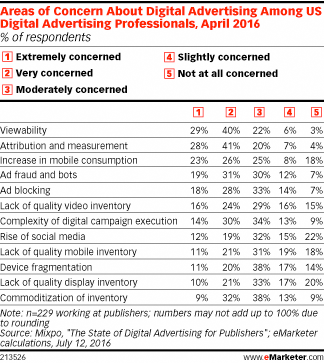Digital Advertising Beyond the Impression
October 18, 2016
![]() The baseline metric for pricing and measuring digital advertising—the served impression—has shaped digital media for more than two decades, as explored in a new eMarketer report, “Attention and Engagement Metrics: Going Beyond the Impression”.
The baseline metric for pricing and measuring digital advertising—the served impression—has shaped digital media for more than two decades, as explored in a new eMarketer report, “Attention and Engagement Metrics: Going Beyond the Impression”.
 A history of ever-decreasing CPMs for display ads meant that publishers had to achieve massive scale to deliver enough impressions to make money from digital. This led to creating clickbait, slideshows, unskippable pre-roll video ads and other content that was hard to avoid but also frequently low quality.
A history of ever-decreasing CPMs for display ads meant that publishers had to achieve massive scale to deliver enough impressions to make money from digital. This led to creating clickbait, slideshows, unskippable pre-roll video ads and other content that was hard to avoid but also frequently low quality.
“The CPM model that has valued consumer time is at such a low rate that people are being bombarded with ads all the time,” resulting in the rise of ad blocking and people opting to pay a premium for ad-free experiences, according to David Levy, co-founder and COO of digital video ad tech provider true[X].
 As impressions continued to lose value, advertisers started asking questions about the quality and efficacy of served impressions: How many real, live humans were on the other side of all those impressions being served? And were those ads being served to them on-screen long enough for them to take notice?
As impressions continued to lose value, advertisers started asking questions about the quality and efficacy of served impressions: How many real, live humans were on the other side of all those impressions being served? And were those ads being served to them on-screen long enough for them to take notice?
One key result of trying to get those questions answered and achieving more accountability was the viewability standard put forth by the Media Rating Council (MRC) in 2014, which publishers and agencies have been working to meet ever since. The MRC states that 50% or more of a display ad’s pixels should be in-view for 1 continuous second or longer, or 2 continuous seconds for video.
This push for viewability remains top of mind among publishers. According to April 2016 research from ad tech provider Mixpo, 29% of US digital ad professionals working at publishers said they were extremely concerned about viewability, slightly edging out another important issue: attribution and measurement. Only 3% reported that they were not at all concerned about the issue.
Many in the industry see meeting the viewability standard as simply a first step in achieving better measures for digital ad effectiveness, particularly around attention and engagement.
“We knew that viewability was just a building block,” said Jason Kint, CEO of Digital Content Next (DCN), an industry trade group representing premium digital publishers. “Once we know an ad has the opportunity to be seen, the most important metric to add to that is the time in which the ad has been exposed to the audience.”
There is some evidence that digital ads exceeding the MRC standard are more effective at meeting brand goals like improving recall, based on a study published in February 2016 by IPG Media Lab, Cadreon and Integral Ad Science. When examining both time and percent of pixels the ads were in-view, ads that were above the MRC standard produced a statistically significant improvement in ad recall among US internet users polled.
Courtesy of eMarketer






























